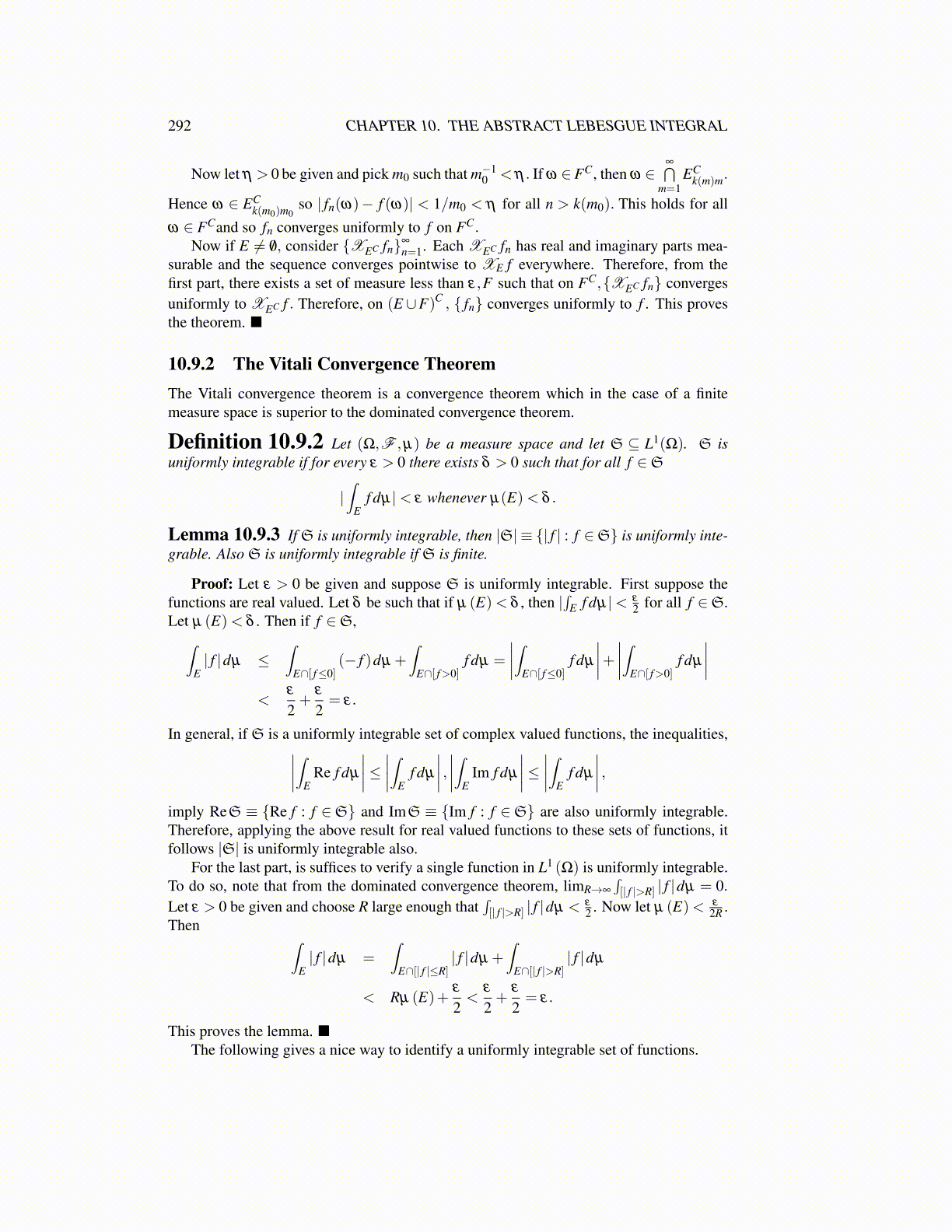
292 CHAPTER 10. THE ABSTRACT LEBESGUE INTEGRAL
Now let η > 0 be given and pick m0 such that m−10 < η . If ω ∈FC, then ω ∈
∞⋂m=1
ECk(m)m.
Hence ω ∈ ECk(m0)m0
so | fn(ω)− f (ω)| < 1/m0 < η for all n > k(m0). This holds for all
ω ∈ FCand so fn converges uniformly to f on FC.Now if E ̸= /0, consider {XEC fn}∞
n=1. Each XEC fn has real and imaginary parts mea-surable and the sequence converges pointwise to XE f everywhere. Therefore, from thefirst part, there exists a set of measure less than ε,F such that on FC,{XEC fn} convergesuniformly to XEC f . Therefore, on (E ∪F)C , { fn} converges uniformly to f . This provesthe theorem. ■
10.9.2 The Vitali Convergence TheoremThe Vitali convergence theorem is a convergence theorem which in the case of a finitemeasure space is superior to the dominated convergence theorem.
Definition 10.9.2 Let (Ω,F ,µ) be a measure space and let S ⊆ L1(Ω). S isuniformly integrable if for every ε > 0 there exists δ > 0 such that for all f ∈S
|∫
Ef dµ|< ε whenever µ(E)< δ .
Lemma 10.9.3 If S is uniformly integrable, then |S| ≡ {| f | : f ∈S} is uniformly inte-grable. Also S is uniformly integrable if S is finite.
Proof: Let ε > 0 be given and suppose S is uniformly integrable. First suppose thefunctions are real valued. Let δ be such that if µ (E)< δ , then |
∫E f dµ|< ε
2 for all f ∈S.Let µ (E)< δ . Then if f ∈S,∫
E| f |dµ ≤
∫E∩[ f≤0]
(− f )dµ +∫
E∩[ f>0]f dµ =
∣∣∣∣∫E∩[ f≤0]f dµ
∣∣∣∣+ ∣∣∣∣∫E∩[ f>0]f dµ
∣∣∣∣<
ε
2+
ε
2= ε.
In general, if S is a uniformly integrable set of complex valued functions, the inequalities,∣∣∣∣∫ERe f dµ
∣∣∣∣≤ ∣∣∣∣∫Ef dµ
∣∣∣∣ , ∣∣∣∣∫EIm f dµ
∣∣∣∣≤ ∣∣∣∣∫Ef dµ
∣∣∣∣ ,imply ReS ≡ {Re f : f ∈S} and ImS ≡ {Im f : f ∈S} are also uniformly integrable.Therefore, applying the above result for real valued functions to these sets of functions, itfollows |S| is uniformly integrable also.
For the last part, is suffices to verify a single function in L1 (Ω) is uniformly integrable.To do so, note that from the dominated convergence theorem, limR→∞
∫[| f |>R] | f |dµ = 0.
Let ε > 0 be given and choose R large enough that∫[| f |>R] | f |dµ < ε
2 . Now let µ (E)< ε
2R .Then ∫
E| f |dµ =
∫E∩[| f |≤R]
| f |dµ +∫
E∩[| f |>R]| f |dµ
< Rµ (E)+ε
2<
ε
2+
ε
2= ε.
This proves the lemma. ■The following gives a nice way to identify a uniformly integrable set of functions.